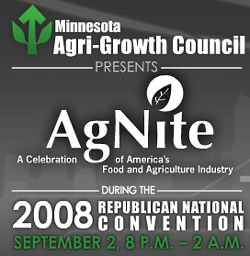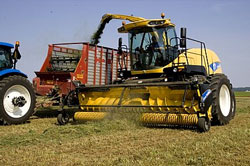 It looks like republicans will be getting a dose of agriculture this fall when they get together for their convention.
It looks like republicans will be getting a dose of agriculture this fall when they get together for their convention.
The Minnesota Agri-Growth Council is hosting AgNite, a celebration of America’s food and agriculture industry, Tuesday, Sept. 2, 2008, during the second night of the Republican National Convention in the Twin Cities.
The evening event will showcase the food, agriculture and energy industries in a unique and exciting club atmosphere, featuring high-tech, interactive displays, cutting-edge visual effects, top-notch food and beverage selections and headline entertainment at the end of the evening.
“AgNite will be a grand celebration representing the scale and diversity of today’s food and agriculture industry,” says Daryn McBeth, president, Minnesota Agri-Growth Council. “The historic significance of The Depot, located in the heart of Minneapolis’ original milling district, will provide an inspiring setting for what will be the food and agriculture event when 50,000 visitors are in town for the GOP National Convention.”

 In just a few short weeks it’s going to be time for the Ag Media Summit once again. Are you ready for the games to begin? The boys for
In just a few short weeks it’s going to be time for the Ag Media Summit once again. Are you ready for the games to begin? The boys for  Since my email box has been a little less full than normal I know that means that most of you are on break now. Well, it’s time to take a break here at ZimmComm World Headquarters too.
Since my email box has been a little less full than normal I know that means that most of you are on break now. Well, it’s time to take a break here at ZimmComm World Headquarters too. High speed internet access is growing in America and according to a new study by the
High speed internet access is growing in America and according to a new study by the 
 I’m not sure yet how well this will work but the first time I tried it things went okay. I can now update
I’m not sure yet how well this will work but the first time I tried it things went okay. I can now update  I’m sure I’m waiting in line to meet the new Director of Communications for the
I’m sure I’m waiting in line to meet the new Director of Communications for the 